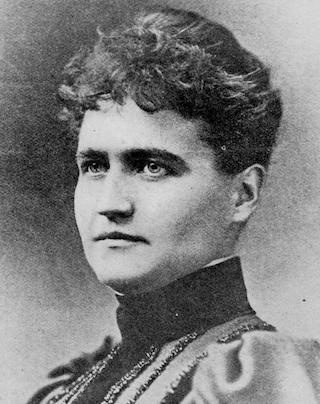the john muir exhibit - people - eliza ruhamah scidmore
Eliza Ruhamah Scidmore
Alaska explorer, journalist, and conservation advocate
1856-1928

- Journalist, travel writer and friend of John Muir and his wife Louie.
- Eliza Scidmore visited Alaska for the first time in the summer of 1883, inspired by John Muir's reports of his Alaska explorations in 1879 and 1880. She and her fellow passengers on the steamship Idaho became the first tourists in Glacier Bay.
-
During the Idaho's voyage that summer, Captain Carroll decided to name the mighty glacier and its inlet for John Muir. Eliza would reveal years later that it was she who conveyed the news to Muir during a visit with him and Louie at their home in Martinez. His reply was laconic, she noted, as he asked her only: "Which one of the glaciers do they call mine?" Eliza Scidmore, "The Discovery of Glacier Bay,"[read via off-site link to Google books] National Geographic April, 1896. p. 144.
- Scidmore wrote the first book-length travelogue on Alaska, Alaska: Its Southern Coast and the Sitkan Archipelago (1885), and gave a copy to John Muir which remains in his historical library at the University of the Pacific today. She later wrote a more comprehensive guidebook (1893), among the 7 books she would write. Mount Ruhamah and Scidmore Glacier and Bay are named for her.
- Scidmore wrote several letters to John Muir and his wife and visited them in Northern California. Their mutual friends included Jeanne Carr, Capt. Calvin L. Hooper, and Harry Fielding Reid.
- In 1892 Scidmore became the first female board member of the National Geographic Society. Her articles in National Geographic included one defending John Muir as the "discoverer" of Glacier Bay. According to both Scidmore and the National Park Service, actually the first American to actually reach Glacier Bay was Charles Wood, a West Point graduate and former frontier soldier, during an 1877 expedition to climb Mount St. Elias. In later years, whenever the subject was broached, Wood disclaimed any attempts to label him as the true Euro-American discoverer of Glacier Bay. This honor he believed rightly belonged to the man whose name has become synonymous with Glacier Bay, John Muir. See U.S. National Park Service, NATIONAL REGISTER OF HISTORIC PLACES MULTIPLE PROPERTY DOCUMENTATION FORM, "Rediscovery, Scientific Study, and Tourism within the Glacier Bay". 1997. Scidmore concludes: "Lieutenant Wood was the Lief Eriesson, Mr Muir the Columbus, in this instance."
- An early proponent of conservation, Scidmore wrote for the influential magazine The Century on the country's new system of national forest reserves. See "Our New National Forest Reserves" by Eliza Ruhamah Scidmore The Century Magazine, September 1893, pp. 792-796.
- An extensive world traveler, she had deep knowledge of the Far East and wrote books on Japan, Java, China and India.
- In her best-known legacy, Scidmore introduced the idea of planting Japanese cherry trees in Washington and helped make it a reality in 1912 by enlisting the support of First Lady Helen Taft.
- In 1928 she died in Geneva, Switzerland at the age of 72, but was buried with her mother and brother in Yokahama, Japan.
-
The first book-length biography of Eliza Scidmore is Eliza Scidmore: The Trailblazing Journalist Behind Washington's Cherry Trees by Diana P. Parsell (Oxford University Press, 2023). Chapter 9 of this book, "Among the Scientists" deals extensively with Scidmore's friendship and time spent with John and Louie Muir, especially with reference ot explorations in Glacier Bay, Alaska.
- For more information, see the blog entry "Eliza Scidmore Joins John Muir Website" in this website of Eliza Scidmore's biographer Diana Parsell.
- Diana Parsell
Home
| Alphabetical Index
| What's New